KEENE, N.H., Sept. 1, 2006 -- Optical Filter Corp. (dba Corning NetOptix), a wholly owned subsidiary of Corning Inc., is a premier optics manufacturer that has the capability to provide optomechanical components and advanced imaging systems.
 |
Corning NetOptix headquarters in Keene, N.H. (Photo: Photonics.com)
|
Corning NetOptix has been doing business in Keene for nearly 20 years. Corning NetOptix was purchased by Corning Inc. in May 2000 and now has the worldwide reputation for being the premier supplier of reflective telescope technologies for infrared (IR) and visible light applications. (Find out about Corning NetOptix's recent expansion here) 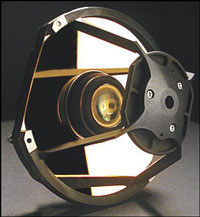
An airborne catadioptric telescope made by Corning NetOptix.
Over the last five years, Corning NetOptix has been integrating with Corning's other operations to identify synergistic opportunities. Corning NetOptix works with Corning Tropel, located in Fairport, N.Y., which is also wholly owned by Corning. Corning Tropel designs and fabricates precision-grade optical subsystems and manufactures a line of optical-based metrology instruments.
Corning NetOptix has collaborated closely with Corning's Canton, N.Y., plant, where Corning manufactures high-purity fused silica glass used in the semiconductor industry and lightweight glass mirror blanks. Corning also conducts extensive research at its Erwin, N.Y.-based research facility, in vast areas of potential and existing markets including display technologies, telecommunications, environmental technologies and life sciences. 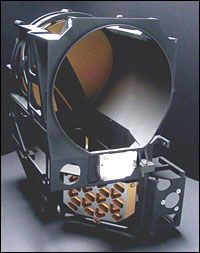
Corning NetOptix's aluminum dual-band telescope.
The expertise that Corning possesses in these industries provides a host of new business opportunities for Corning NetOptix. No other competitor has a similar vertically integrated model supported by hundreds of PhD-level scientists.
Corning NetOptix has experienced tremendous growth over the last four years, and with its affiliation with other Corning businesses, Corning NetOptix can offer "one-stop shopping" for many of its customers. Corning NetOptix, working collaboratively with its affiliates, can provide expertise in the fields of raw materials and material science; optical-, environmental-, and system-level design and test; and full-up integration and test of optical sensor systems. As a result, Corning NetOptix, together with its affiliates, offers customers a complete solution.
Providing Custom Optical Components for Outer Space
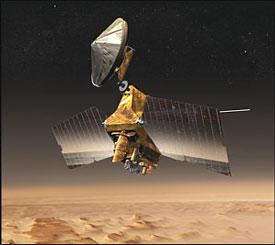
A graphic representation of the Mars Reconnaissance Orbiter as it flies over Mars. The spacecraft's solar panels are spread open. (Image: NASA)
Blasting off aboard NASA's most recent mission to Mars is the Mars Climate Sounder, an instrument developed by NASA's Jet Propulsion Laboratories (JPL) that includes mirrors developed by Corning NetOptix for the instrument's telescopes. The instrument will help scientists understand and predict the weather patterns and climate of the Red Planet.
The Mars Reconnaissance Orbiter launched into space on Aug. 12, 2005, beginning a 310-million-mile journey to Mars. Reaching Mars' orbit in March 2006, the orbiter is currently adjusting to the planet's atmosphere and will begin collecting data in October.
To gather information on the planet, the orbiter is equipped with six instruments -- one of which is the Mars Climate Sounder -- to examine the planet in unprecedented detail, studying every level of Mars from its underground layers to the top of its atmosphere.
What is the Mars Climate Sounder?
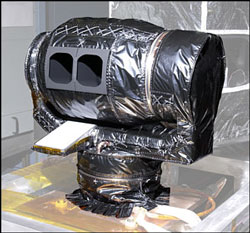
NASA's Mars Climate Sounder, which includes mirrors developed by Corning NetOptix for the instrument's telescopes. (Photo: NASA)
On the mission, the Mars Climate Sounder will study water vapor, dust, ices and temperatures in Mars' atmosphere. It will assess how they vary with altitude, map how they are distributed around the planet, and monitor their changes from day to night and from season to season.
Data will continue to be collected over the course of a full cycle of Martian seasons and combined into daily, three-dimensional global weather maps of the planet. These maps will provide scientists with the same type of information meteorologists use to understand and predict both weather and climate here on Earth. The Mars Climate Sounder will also help researchers examine how solar energy interacts with the atmosphere and the planet surface.
Capturing this data is no easy task. The Mars Climate Sounder uses a pair of telescopes with apertures of 1.6 inches, articulated so that, without repositioning the spacecraft, the telescopes can point sideways to the horizon or straight down onto the planet using nine channels across the visible and IR ranges of the spectrum.
How did Corning NetOptix get involved?
NetOptix has a long history of working with JPL on smaller projects, so JPL approached the division and asked if NetOptix was interested in aiding in the production of mirrors for the telescopes on the Mars Reconnaissance Orbiter, explained Scott Flint, director of sales and marketing for NetOptix.
"The project was initiated in September of 2002 at our Keene location and touched many hands throughout the process," said Scott. "The job required concurrent engineering, diamond machining, electroless nickel plating, post polishing, optical coating, metrology and certification for space flight."
Mission objectives
The Mars Reconnaissance Orbiter is one of many devices that NASA is using to establish a sustained observational presence both on and around the surface of Mars. During the Orbiter's primary science phase, running from November 2006 through December 2007, the device is expected to produce 34 terabits of data -- five times the amount collected on all other Mars' missions combined.
Scientists will analyze the torrents of information to gain a better understanding of changes in the planet's atmosphere and the processes that have formed or modified its surface. Researchers are especially interested in water and whether it's ice, liquid or vapor. Learning more about where the water is today and where it was in the past will also guide future studies about whether Mars supported life.
Future Collaboration
In addition to the Mars Climate Sounder project, Corning NetOptix is currently producing spectrometer components to support the M3 (Moon Mineralogical Mapper), which is scheduled to fly as part of the scientific payload for the Indian Space Research Organization's Chandraayan-1 mission, slated for launch in 2007. Customers like JPL continue to call on the company because of Corning's collective capability set and its people.
Diamond Machining: Critical for Making High-End Optical Components
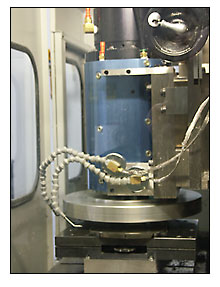
A machining tool (blue column) with an extremely sharp, tiny diamond tip scrapes the surface of an unseen optical component to give it a highly accurate reflective surface. (Photo: Photonics.com)
Diamond machining, or the process for fabricating highly accurate optical and optomechanical components that require micro-inch dimensional tolerances, is a core part of Corning NetOptix's technology and its success. Corning NetOptix can diamond turn non-ferrous metals such as aluminum, copper, brass, titanium, nickel and gold -- as well as IR crystals and plastics, from very micro-optics to on-axis optical components up to 32 in. in diameter. Corning NetOptix has the largest number of diamond machines under one roof in the world.
Coatings: The Finishing Touch
Corning NetOptix also draws a competitive advantage from the technology it developed during the late 1990s and early 2000. Corning NetOptix's optical coating chambers can lay down both reflective metal coatings and anti-reflective coatings on many materials. These machines have multiple modes of coating deposition and are all configured with the necessary tooling, including planetaries and coating masks, to optimize a controlled coating deposition.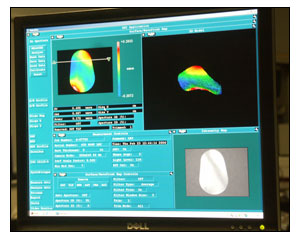
Detailed software programs constantly monitor the accuracy of Corning NetOptix's forms and surface finishes. (Photo: Photonics.com)
Because the majority of Corning NetOptix's current business opportunities are in the aerospace industry, not only do the optical components need to meet challenging optical performance specifications, but they also need to stand up to demanding environmental specifications. Components and coatings are put through extensive in-house tests that measure their strength and durability. Testing includes subjecting components and coatings to salt/fog, humidity, temperature influence, and adhesion and abrasion tests.
The new front lobby was part of Corning NetOptix's most recent expansion project. (Photo: Photonics.com)
With increased business also comes the need for experienced engineers and other professionals. Corning NetOptix is looking for talented people across all business functions. (visit Corning's recruitment site here)
For more information, visit: www.corning.com
Corning NetOptix Inc.
Diamond Turning Div.
69 Island St.
Keene, NH 03431
Phone: (603) 357-7662
Fax: (603) 357-7764